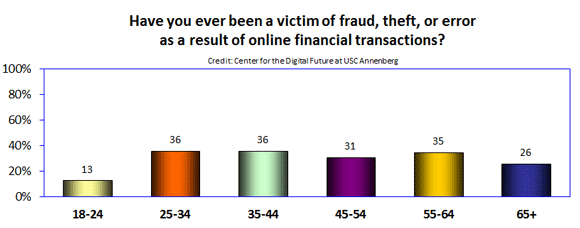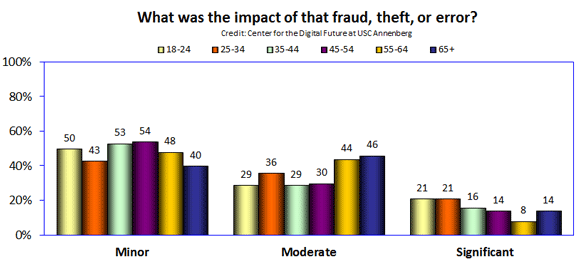The Center’s upcoming Future of Banking and Money Study explores illegal activity and problems with transactions when banking online.
In the world of online financial transactions, how common are fraud, theft, or error?
The Center’s study on the future of money and banking found that 31% of those who bank on the internet said they have been victims of fraud, theft, or error as a result of online financial transactions.
The Center found:
Women (34%) are more likely than men (27%) to have been victimized.

Age also plays a role. Those age 18-24 are least likely to have had these problems — a result to be expected given their fewer years of online experience.
For those age 25-34 and 35-44, 36% have suffered from some of these problems, as have 35% of people between the ages of 55 and 64, 31% of 45-54 year olds, and 26% of those aged 65 and above.

How significant are the problems of fraud, theft, or error in online financial transactions?
The differences between men and women who have been victimized are small. Forty-five percent of men and 51% of women said the problem was minor in time, inconvenience, and/or financial consequences.
Thirty-nine percent of men and 33% of women said the problem was moderate in time, convenience, and/or financial consequences. And 15% of both men and women said the problem was significant in time, convenience, and/or financial consequences.
So overall, the trouble was perceived to be slightly more serious by men.

What about age? What proportion of the different age cohorts said the problem was minor in time, inconvenience, and/or financial consequences?
It was minor for 54% of 45-54 year olds, 53% of 35-44 year olds, 50% of 18-24 year olds, 48% of 54-65 year olds, 43% of 25-34 years olds, and 40% of those over 65.
What percentage of each age group said the problem was moderate in time, inconvenience, and/or financial consequences? It was moderate for 46% of those over 65, 44% of 54-65 year olds, 36% of 25-34 years olds, 30% 45-54 year olds, and 29% of 18-24 and 35-44 year olds.
What share of the different age category groupings say the problem was significant in time, inconvenience, and/or financial consequences? It was significant for 21% of 18-24 and 25-34 years olds, 16% of 35-44 year olds, 14% of 45-54 year olds and those above 65, and 8% of 55-64 year olds. There seem to be few patterns regarding age beyond the younger users being somewhat more prone to the most serious difficulties, and the oldest users being somewhat more prone to moderate problems.

__________
See all Web Insights.
August 22, 2017

